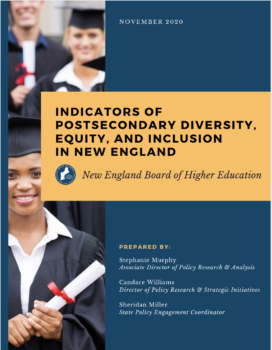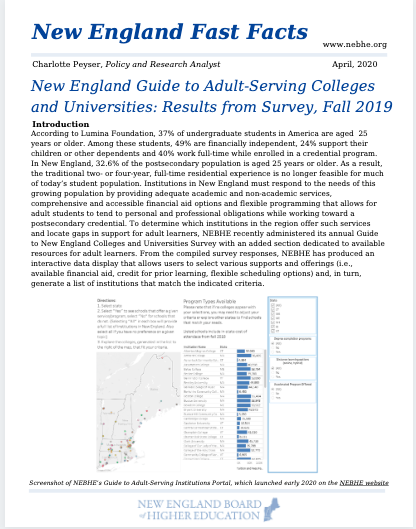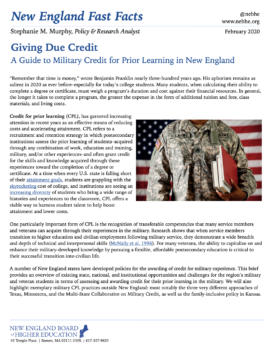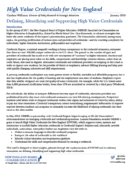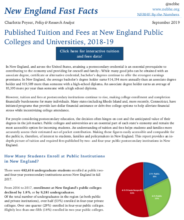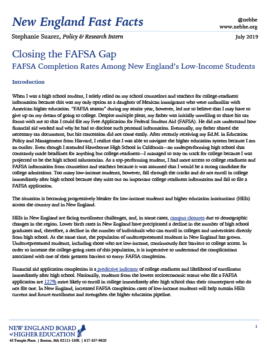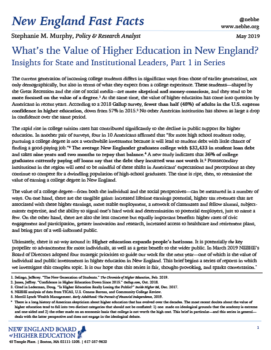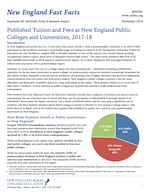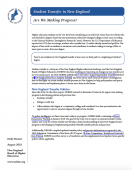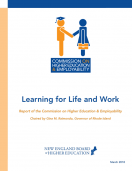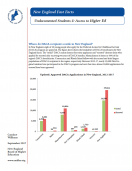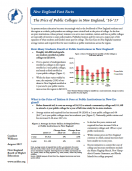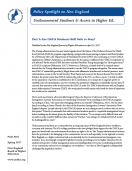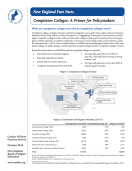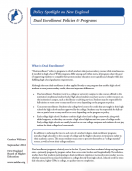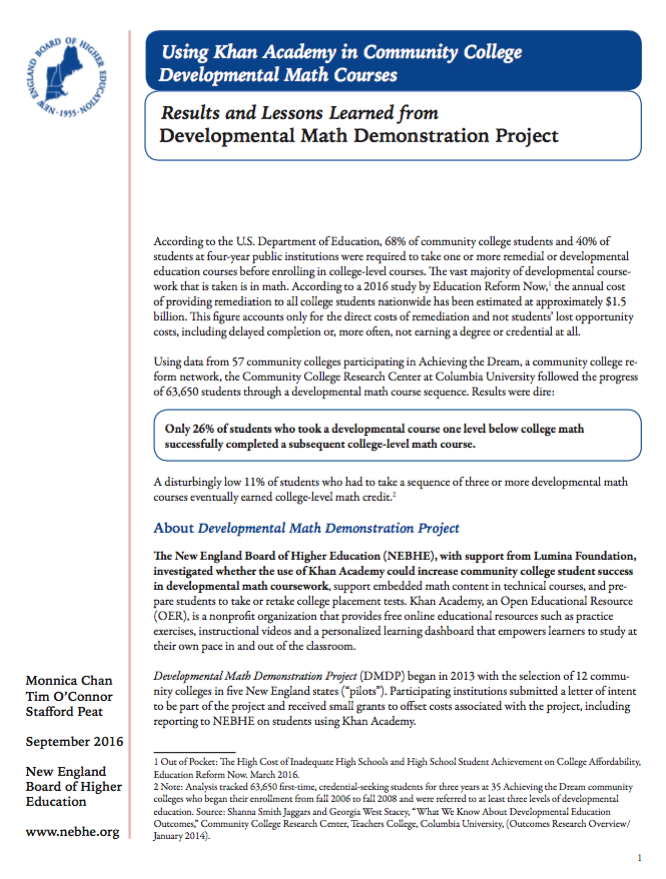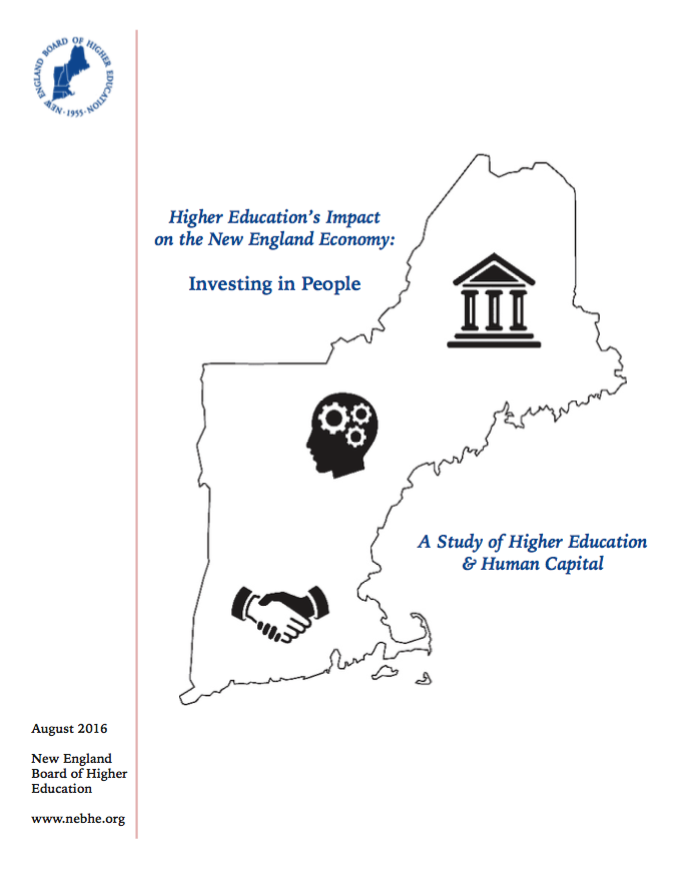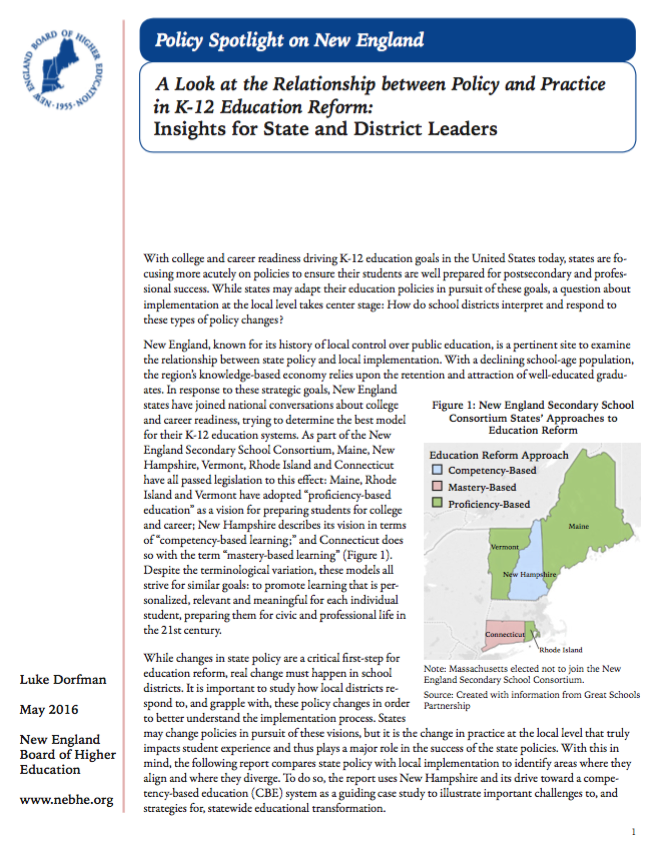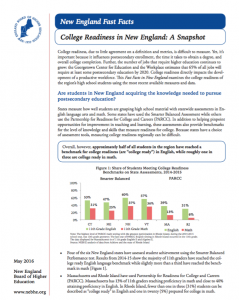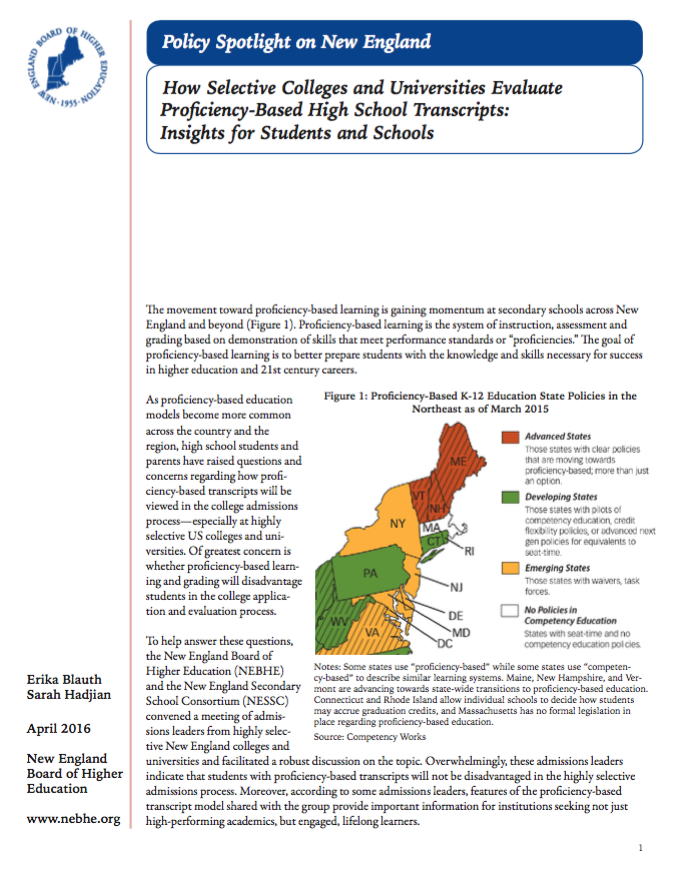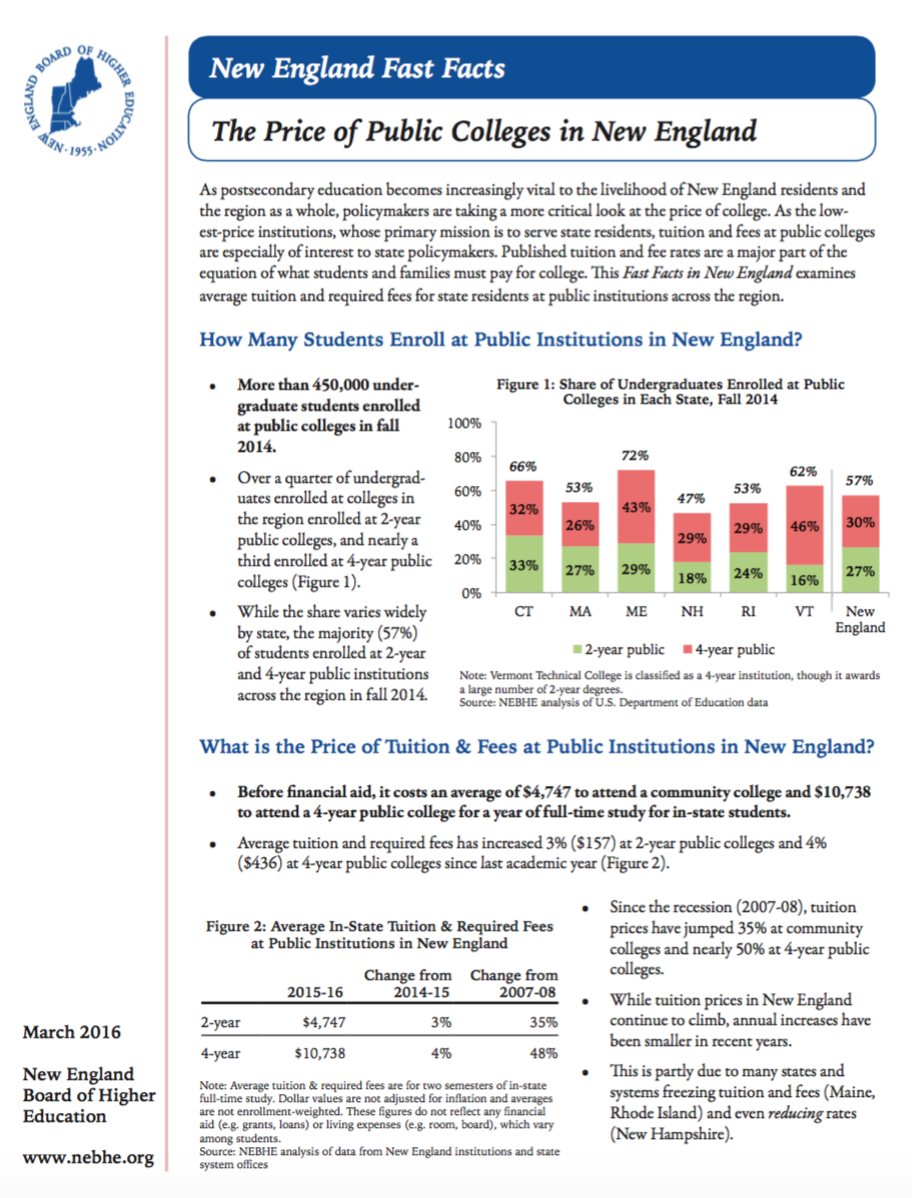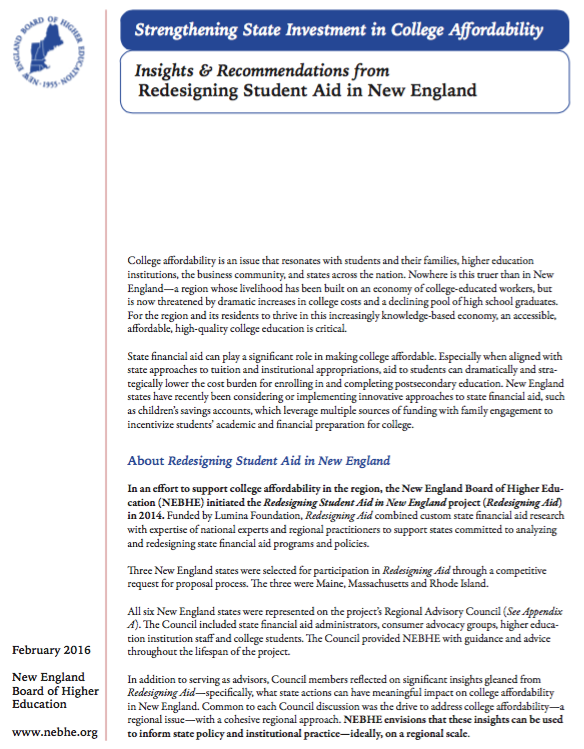The Policy & Research team serves as a critical resource to higher education decision-makers, policy leaders, legislators and business leaders across New England informing action through research, analysis and best practices shaped by strong collaboration and shared expertise.
Note: the Policy & Research website is currently undergoing a redesign process, and we are excited to share updated content with you shortly. As a result, the reports on this page may contain out-of-date information or statistics. While we work to update our web resources, we encourage you to contact us with questions about how to reference the resources on our webpage or submit a request for updated data.
Living Up to the Promise? Exploring Issues of Access and Equity among New England’s Promise Programs
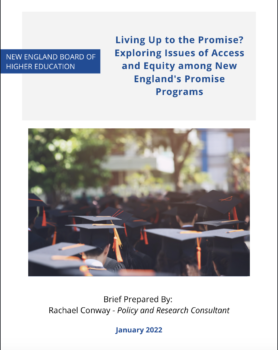
<!–
January 2022
This report provides a comprehensive look at the availability and efficacy of Promise Programs (or free college programs) in New England. In her report, Rachael Conway juxtaposes the differences between nine New England programs, and details helpful policy suggestions for legislators looking to expand equitable access to free college in New England.
Published Tuition and Fees at Public Colleges and Universities in New England, 2020-21
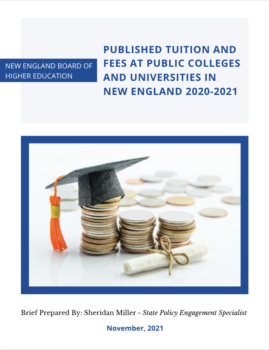
December 2021
This report provides a look into the tuition and fees at public two and four-year institutions in New England. As institutions grappled with the effects of the coronavirus pandemic, some HEI’s subsequently adjusted their tuition and fees to bolster affordability for in-state students in a time of economic turmoil. Learn more about metrics like tuition and fees, enrollment data, and relevant legislation by clicking above.
Adult Learners in New England: 2021 Fact Sheets
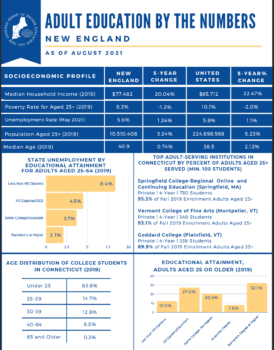
August 2021
Diversity, Equity, and Inclusion of New England’s Postsecondary Faculty and Scholars: State Data Sheets
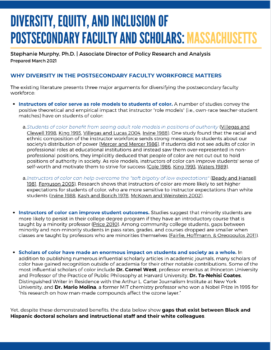
March 2021
NEBHE’s latest fact sheets explore data around faculty diversity at New England’s postsecondary institutions, including the demographic “mismatch” between BIPOC faculty and BIPOC students, the production of doctoral scholars of color in the region, and the distribution of academic rank by race and ethnicity at our region’s institutions of higher education. Click below to see the state-specific data.
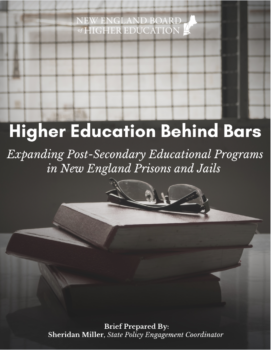
- Lower education levels are associated with higher rates of recidivism. Federally, those without a high school education recidivate at a rate of 60%, compared to those with some college experience who at a rate of 19.1%.
- Educating the formerly incarcerated not only reduces recidivism, it also improves our regional economy. For every dollar spent on educational programming behind bars, taxpayers save $4-$5, depending on the state.
- Higher education can be life changing for a formerly incarcerated person. Having some college experience makes it easier to find a job post-release, which has a resounding personal impact, as well as a significant long-term generational one.
Indicators of Postsecondary Diversity, Equity, and Inclusion in New England
*Updated December 4, 2020*
Due to a calculation error, the November report (p. 11) and the state fact sheets misstated the racial and ethnic composition of undergraduate students in New England. We have corrected this error, and the updated report and facts sheets are now linked below.
Diversity. Equity. Inclusion.
These words have dominated the national conversation in recent weeks. From the racial justice protests that have sprung up across the U.S. since the death of George Floyd, to the White House’s recent executive order against the “malign ideology” of diversity training efforts in federally funded programs, individuals from both sides of the political aisle have had a lot to say on the matter.
This report examines the disparities that exist in the region along racial and ethnic lines, many of which begin at birth and persist through young adulthood and beyond. The report draws from multiple data sources to provide measures of postsecondary equity, diversity and inclusion in five areas: college readiness, access and enrollment, college affordability, post-college success, and faculty diversity at New England’s postsecondary institutions.
State Fact Sheets:
Published Tuition and Fees at Public Colleges and Universities in New England, 2019-20
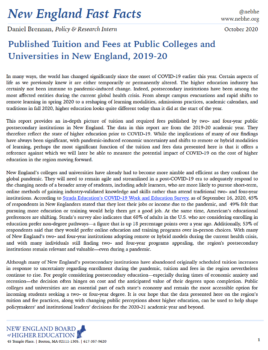
October 2020 (edited November 5, 2020)
This report provides an in-depth look at tuition and required fees published by two- and four-year public postsecondary institutions in New England for the 2019-20 academic year. Although many of the region’s postsecondary institutions have abandoned originally scheduled tuition increases in response to uncertainty regarding enrollment during the pandemic, tuition and fees in the region nevertheless continue to rise.
New England Guide to Adult Serving Colleges and Universities: Results from Fall 2019 Survey
This brief details the results from the New England Guide to Adult Serving Colleges and Universities Survey, issued to all colleges and universities in New England in summer 2019. Ninety-four of 250 institutions responded to the survey. Highlights from the Guide Survey include:
- 30% of institutions offer weekend courses
- 46% offer hybrid program options (partially online, partially in-person)
- 66% offer fully online programs
- 42% have an on-campus food pantry
- 48% have an emergency fund available to students in need
- 56% do not have time limits on credits eligible for transfer
- 42% offer adult degree completion programs
Giving Due Credit: A Guide to Military Credit for Prior Learning in New England
This report provides an overview of existing opportunities and challenges for the region’s military and veteran students in terms of assessing and awarding credit for their prior learning (CPL) in the military. Five New England states – Connecticut, Maine, Massachusetts, New Hampshire, and Rhode Island – have legislation requiring a state agency, college system, or individual institutions to develop and adopt a policy on academic credit for a student’s military occupation, military training, coursework, and experience.
Even so, there is room for improvement in the region’s existing policies:
- Half of New England lacks a uniform state-wide military CPL policy. Among existing military CPL policies in the region, Connecticut and Maine require system-wide procedures, whereas laws in Massachusetts, New Hampshire, and Rhode Island stipulate that such procedures ought to be established by each individual institution. Vermont does not have an official policy regarding military CPL.
- The Region Lacks Clear Communication About Its Policies and Their Impact. States could benefit from requiring their college and university systems to provide status updates on their CPL assessment policies to the legislature, as well as making these policies easily accessible to the public online.
- Affordability Remains Problematic. Many CPL options available to servicemembers are costly and provide no guarantee that they will be accepted by institutions for credit.
Adult Learners in New England: By the Numbers
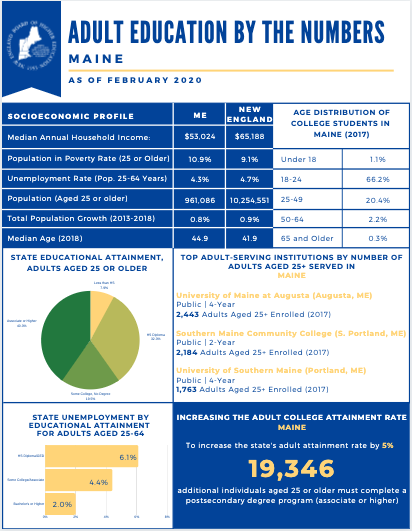
February 2020
State fact sheets detailing data about adult learners in the region. Each fact sheet includes:
- Age distribution of college students
- Educational attainment of adults
- Unemployment rates of adults by attainment level
- Top adult-serving institutions
Defining, Identifying and Supporting High Value Credentials
The growth in the number of types and providers of credentials has much to do with new conceptions of the “currency” of higher education. Students and employers are placing more value on the skills, competencies and knowledge a learner obtains, rather than on credit hours, seat-time or degrees. Alternative credentials and credential providers are adapting to this trend in order to capture new students, be the provider-of-choice to employers, advance lifelong learning and keep pace with quickly changing industries and skill requirements.
A growing credentials marketplace may mean greater access to flexible, stackable and affordable programs, but it also has implications for the quality of learning and the employment outcomes of students. For individuals, the ability to interpret differences between types of credentials, education providers and professional benefits that come with credential attainment can have life-altering consequences.
This brief is designed to share insights, gleaned through the implementation of HVCNE and its advisory committee, on defining, identifying and supporting high value credentials.
New England Fast Facts: The Price of Public Colleges in New England, 2018-19
Since the 2013-14 academic year, tuition and required fees in New England have risen 21% ($959) at public community colleges and 18% ($1,811) at public four-year colleges, according to NEBHE’s 2018-19 Tuition and Fees Report. This report, published annually by NEBHE’s Policy & Research team, takes an in-depth look at the tuition and required fees published by public two- and four-year postsecondary institutions across New England. It explores emerging trends by providing a historical analysis of tuition and fees in the region to shed light on college prices, as well as legislative and institutional initiatives that seek to address affordability challenges.
Closing the FAFSA Gap: FAFSA Completion Rates Among New England’s Low-Income Students
This brief examines available FAFSA completion data to assess how New England is closing the FAFSA completion gap for low-income students. Despite FAFSA completion data limitations, various metrics—such as the relationship between district poverty levels, median household incomes and FAFSA completion rates—provide an understanding of how New England states are supporting the FAFSA completion rates of low-income students. FAFSA completion is vital to the sustainability of higher education institutions (HEIs). The high number of incomplete FAFSA applications harms not only low-income students, but also colleges. Enrollment rates continue to decline in New England because of lower birth rates and changing demographics. Several campuses have been forced to close in New England due to shrinking enrollments. Increased efforts that support FAFSA completion for low-income students will be critical to the vitality of HEIs in New England now and in the future.
This report takes an in-depth look at the available data for New England to make the case for the value of individual and public investments in higher education. It explores regional figures on attainment, income, unemployment, poverty and civic engagement, among other data points. Despite the alarming and unsustainable rise of college tuition and fee rates, the greatest cost associated with higher education is still the opportunity cost in terms of lost wages. The average associate degree holder in New England earns roughly $5,400 (17%) more annually than an individual who does not have an education beyond high school. The corresponding “wage premium” for a bachelor’s degree in the region is even greater: The average four-year college graduate in New England can expect to earn approximately $19,600 (62%) more per year than someone with a high school diploma only.
New England Fast Facts: The Price of Public Colleges in New England, 2017-18
In New England and across the U.S., it has never been more critical to hold a postsecondary credential to be able to fully participate in the workforce and earn a living wage. Yet, in recent years the cost of a college degree has risen precipitously — oftentimes becoming prohibitively expensive for far too many Americans to attend college. New England’s public colleges are the most affordable and financially accessible option for most individuals in the region, and their primary mission is to serve each of their state’s residents. Published tuition and fee rates play a significant role in students’ and their families’ decision about which college to attend to whether to even pursue a college degree. This brief takes an in-depth look at the tuition and required fees published by public two- and four-year postsecondary institutions in New England.
Student Transfer in New England: Are We Making Progress?
Higher education students in the U.S. have been transferring at record levels. More than two-thirds who earn bachelor’s degrees from four-year institutions today have changed colleges at least once according to the National Student Clearinghouse Research Center. However, the U.S. Department of Education reported in 2015 that on average, students who transfer lose 13 credits already earned and paid for. The impact of lost credit on students is enormous and contributes to students taking an average of five or more years to earn a four-year degree. This brief explores if states in the region are making progress in developing policies and practices that: Facilitate transfer; Mitigate credit loss; Offer students who began at a community college and transferred to a four-year institution the opportunity to earn an associate degree through reverse transfer; Offer students who began at a community college and transferred to a four-year institution the opportunity to earn an associate degree through reverse transfer.
March 2018
The New England Board of Higher Education (NEBHE) Commission on Higher Education & Employability released a major report with recommendations to increase the career readiness of graduates of New England colleges and universities and improve their transitions to work. Chaired by Rhode Island Gov. Gina M. Raimondo, the 50-member Commission invested 11 months in public meetings and working group sessions exploring New England employers’ concerns about a lack of qualified, skilled workers, particularly in rapidly changing, technology-intensive and growth-oriented industries. In its report, “Learning for Life and Work,” the Commission offers a strategic action agenda with 18 key recommendations to align institutions, policymakers and employers.
New England Fast Facts: Undocumented Students & Access to Higher Ed
An update to NEBHE’s earlier released report, Policy Spotlight on New England: Undocumented Students & Access to Higher Ed. This Fast Facts includes current figures on the number of DACA participants in New England, as well as legislation before Congress.
New England Fast Facts: The Price of Public Colleges in New England, 2016-17
As postsecondary education becomes increasingly vital to the livelihood of New England residents and the region as a whole, policymakers are taking a more critical look at the price of college. As the lowest-price institutions, whose primary mission is to serve state residents, public colleges’ tuition and fees are especially of interest to state policymakers. Published tuition and fee rates are a major part of the equation of what students and families must pay for college. This Fast Facts in New England examines average tuition and required fees for state residents at public institutions in each New England state and in the region as a whole.
Policy Spotlight on New England: Undocumented Students & Access to Higher Ed
While institutional leadership continues to play a big role in enrolling, retaining and graduating undocumented students, state policy and legislative action is crucial to supporting these students. Undocumented students are ineligible for federal financial aid programs such as Pell Grants, work study and government loans. As a result, these students rely almost exclusively on state support. Twenty states offer some form of financial aid to undocumented students, and most extend in-state tuition to undocumented students. Nationally, six states provide both in-state tuition and state financial aid. In New England, only two states offer financial support. Connecticut and Rhode Island extend in-state tuition to undocumented students if they meet certain criteria such as having attended a state high school for two or more years and graduated.
New England Fast Facts: Completion Colleges: A Primer for Policymakers
Completion colleges may present an affordable, alternative option for adults who’d like to attain a degree and who may otherwise turn to a private for-profit institution. Like many private for-profits, completion colleges are designed to serve adults who have been delayed in completing their degrees by offering more flexibility than many traditional colleges and universities.
Completion colleges do this by aggregating credits earned at other institutions with “prior learning.” Faculty members at completion colleges assess prior learning—college-level skills and knowledge often learned outside the classroom—to ensure that students don’t have to take and pay for courses on content they have already mastered. This “prior learning assessment” (PLA) may come in forms such as student portfolios that demonstrate mastery of course content, a subject assessment offered by the completion college, industry licensure or military experience. Once prior learning credits are applied toward a degree, most of the remaining courses necessary to complete a degree can be taken online.
Policy Spotlight on New England: Dual Enrollment Policies & Programs
For the last 15 years, dual enrollment programs have been a high priority policy to tackle college readiness, affordability, and time to degree, with programs in all six New England states. However, opaque or confusing guidelines can disadvantage students looking to apply their credits to degrees or even leave some groups of students behind.
This NEBHE Policy Spotlight presents a regional overview of dual enrollment policies and programs. In addition, state-by-state program summaries illuminate policy gaps and areas ripe for improvement in New England.
This brief reports on the effectiveness of using Khan Academy in developmental math coursework, career and technical courses and Accuplacer math boot camps. The three-year Developmental Math Demonstration Project was funded by Lumina Foundation and piloted in 12 community colleges across New England. The brief reports on student and instructor perceptions of using Khan Academy as well as project outcomes and challenges encountered by faculty.
Higher Education’s Impact on the New England Economy: Investing in People
Higher education institutions are huge drivers of the New England economy. At a time when the goalposts are moving for the workforce, especially in terms of earning postsecondary degrees and credentials, understanding and supporting higher education’s contribution to the economy is crucial to maintaining regional competitiveness. The first in a new series from NEBHE, Higher Education’s Impact on the New England Economy: Investing in People explores how higher education fuels the regional economy through attracting, developing and retaining its most critical resource: its people.
New England states, historically known as bastions of local control over public education, provide an especially interesting setting for examining the nexus of state policy and local practice. This Policy Spotlight delves into the implementation of a competency-based education system in districts across New Hampshire as a case study to illustrate important challenges to, and strategies for, statewide educational transformation.
New England Fast Facts: College Readiness in New England
College readiness, due to little agreement on a definition and metrics, is difficult to measure. Yet, it’s important because it influences postsecondary enrollment, the time it takes to obtain a degree, and overall college completion. Further, the number of jobs that require higher education continues to grow: the Georgetown Center for Education and the Workplace estimates that 65% of all jobs will require at least some postsecondary education by 2020. College readiness directly impacts the development of a productive workforce. This Fast Facts in New England examines the college readiness of the region’s high school students using the most recent available measures and data.
Policy Spotlight on New England: How Selective Colleges and Universities Evaluate Proficiency-Based High School Transcripts — Insights for Students and Schools
As proficiency-based education models become more common across the country and the region, high school students and parents have raised questions and concerns regarding how proficiency-based transcripts will be viewed in the college admissions process—especially at highly selective US colleges and universities. Of greatest concern is whether proficiency-based learning and grading will disadvantage students in the college application and evaluation process. To help answer these questions, the New England Board of Higher Education (NEBHE) and the New England Secondary School Consortium (NESSC) convened a meeting of admissions leaders from highly selective New England colleges and universities and facilitated a robust discussion on the topic. This Policy Spotlight on New England offers insights from that meeting.
New England Fast Facts: The Price of Public Colleges in New England
As postsecondary education becomes increasingly vital to the livelihood of New England residents and the region as a whole, policymakers are taking a more critical look at the price of college. As the lowest-price institutions, whose primary mission is to serve state residents, public colleges’ tuition and fees are especially of interest to state policymakers. Published tuition and fee rates are a major part of the equation of what students and families must pay for college. This Fast Facts in New England examines average tuition and required fees for state residents at public institutions in each New England state and in the region as a whole.
Strengthening State Investment in College Affordability: Insights and Recommendations from Redesigning Student Aid in New England
In an effort to support college affordability in the region, NEBHE initiated the Redesigning Student Aid in New England project (Redesigning Aid) in 2014. Funded by Lumina Foundation, Redesigning Aid combined custom state financial aid research with expertise of national experts and regional practitioners to support states committed to analyzing and redesigning state financial aid programs and policies. Drawn from discussions of the project’s Regional Advisory Council, this report shares key insights from Redesigning Aid and recommendations for how higher education leaders can strengthen state investment in college affordability.
To request information about NEBHE Policy & Research publications prior to 2016, please email policy@nebhe.org.

